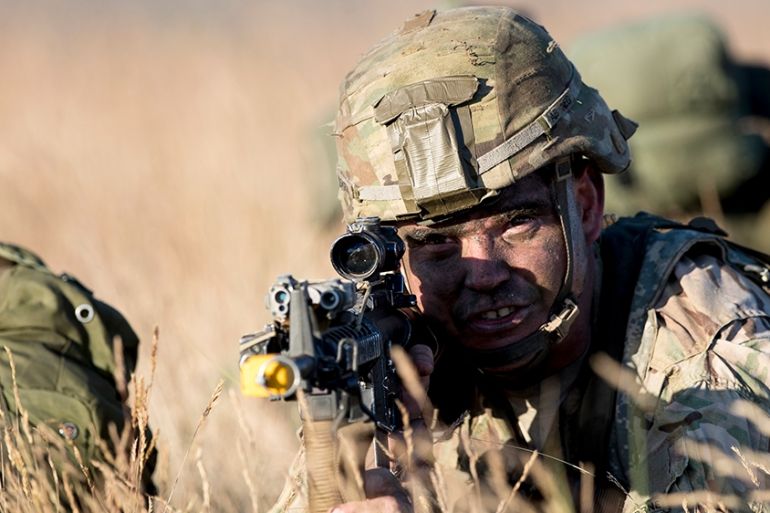NATO launches its largest war games since end of Cold War
Mock battle in Norway will send ‘clear message to any potential adversary’, transatlantic security alliance says.

NATO has launched its biggest military exercises since the end of the Cold War amid rising tensions between the transatlantic security alliance and Russia.
About 50,000 soldiers from 31 countries – comprising NATO’s 29 member states plus Sweden and Finland – are taking part in a mock battle against an invading force in Norway beginning on Wednesday and scheduled to run until November 7.
Keep reading
list of 4 itemsNATO allies must do more as Ukraine runs out of ammunition: Stoltenberg
Nordic tensions on the rise amid Russian anger over NATO accessions
Flag of NATO’s 32nd member, Sweden, raised at alliance’s headquarters
Thousands of military vehicles, hundreds of aircraft and scores of ships will also be deployed as part of the manoeuvres, officially named Trident Juncture 18.
NATO Secretary-General Jens Stoltenberg said the drills would send a “clear message to our nations and to any potential adversary”.
“In recent years, Europe’s security environment has significantly deteriorated … NATO does not seek confrontation but we stand ready to defend all allies against any threat,” Stoltenberg told reporters at a press conference on Wednesday.
Despite US President Donald Trump’s frequent criticism of fellow NATO members’ defence spending, which he has alleged is insufficient, Washington is contributing the biggest individual contingent of troops to Trident Juncture 18.
NATO guidelines declare that member states should allocate a minimum of 2 percent of their gross domestic product (GDP) for annual defence spending by 2024, but many of the organisation’s members do not currently adhere to this.
‘Everybody looking east’
Wednesday’s exercises kicked off just weeks after Russia staged its own largest ever military drills since the end of the decades-long Cold War, which concluded with the dissolution of the Soviet Union in December 1991.
Last year, Russia also conducted war games alongside Belarus, close to the EU’s eastern border and NATO member states Estonia, Latvia, Lithuania and Poland.
![Russia ran large-scale military drills close to the EU's eastern border last year [File: Sergei Grits/AP]](/wp-content/uploads/2018/10/6669262d625e412c8aca6af25a9ab337_18.jpeg)
Against a backdrop of deepening distrust with Moscow, NATO has insisted its ongoing operation is not aimed at simulating a conflict with Russia, which shares a border with Norway.
Al Jazeera’s Alex Gatopoulos, reporting from Norway, said despite no one mentioning Russia “everybody is looking east”.
“We are talking about an exercise in collective security … we have had huge exercises run by Russia over the last two to three years and hundreds of thousands of troops integrating knowledge that they have learned and picked up operationally from the conflict in Syria,” Gatopoulos said.
“NATO is clearly training to respond to this, not only to defend front line states but also to retake them in case there is any future conflict,” he added.
‘Anti-Russian’ exercise
Several recent overtures from NATO – including briefing the Kremlin on the drills and extending a monitoring invite to Russian officials – appear to have done little to placate Russian grievances.
On Wednesday, Russia’s embassy in Oslo said it considered Trident Juncture 18 an “anti-Russian” exercise.
“Such activity … comes across as provocative, even if you try to justify it as being of a purely defensive nature,” it said.
The comments came after Russian foreign ministry spokeswoman Maria Zakharova, speaking earlier in October, condemned what she termed as NATO’s “sabre-rattling”.
“All these NATO preparations cannot be ignored, and the Russian Federation will take the necessary tit-for-tat measures to ensure its own security,” Zakharova told Russia’s state-run TASS news agency on October 2.
“Such irresponsible actions will inevitably destabilise the military and political situation in the north,” she added.
US-Russia tensions
For months, Moscow has been irked by a growing Western military presence in the region, with the United States and the United Kingdom – both NATO member states – increasing troop deployments in Norway to condition their forces for cold weather combat.
Tensions between the US and Russia appeared to ramp up this week after US President Donald Trump said he would withdraw from the landmark Cold-War era Intermediate-Range Nuclear Forces (INF) treaty.
The INF, an arms-control agreement which rid Europe of land-based nuclear missiles by banning all nuclear and conventional missiles with ranges of 500 to 5,500km, was signed in 1987 at a Washington summit between the then-US President Ronald Reagan and Soviet General-Secretary Mikhail Gorbachev.
Washington and Moscow have frequently traded barbs over the accord in recent years, accusing one another on several occasions of breaching the terms of the treaty.
Following a meeting with US National Security Advisor John Bolton in Moscow on Wednesday, Russian President Vladimir Putin warned the Kremlin would respond in kind if the US withdrew from the deal and deployed missiles in Europe.
“If they will deliver them [missiles] to Europe, naturally our response will have to mirror this,” Putin said.